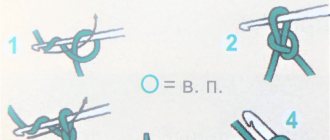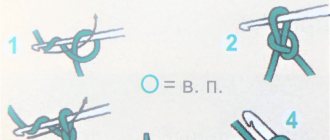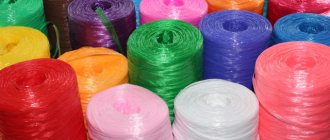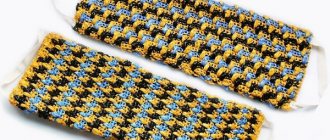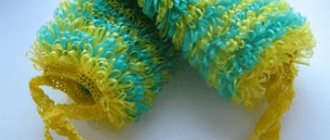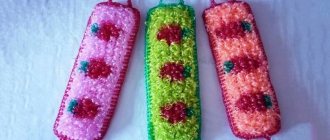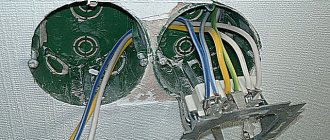Everyone uses washcloths. Mostly they are bought, but due to the fact that washcloths stretch quickly, it is not entirely profitable. Today we will talk about how to knit a shower sponge using a hook with difficult elongated loops or regular ones - it takes little time, and the costs are significantly reduced. Our master class today is dedicated to this very topic.
- MK for beginners on crocheting washcloths according to patterns
- Let's look at the step-by-step instructions with a description of the work
- We create a washcloth-mitten with our own hands from a photo
- Step-by-step instructions for creating a shower product
We strongly recommend watching the training video.
Making useful things for everyday life with your own hands is a very good hobby!
Crochet Basics
For those who have already mastered them, scroll on. For those just starting to figure it out, here are some tips:
Air loop
Double crochet
Single crochet
Connecting post
Follow the links and watch the step-by-step description with video
- How to learn to crochet
- Adding and decreasing stitches with crochet. Long loops
Classic twine washcloth. Master class for beginners.
Only for true connoisseurs of hard washcloths! Even a novice needlewoman, following our tips, can make such a thing in just a couple of hours.
We will need:
- a ball of sisal twine (can be purchased at a hardware store);
- hook number 12.
Master Class
We wrap the twine around the index finger, making a loop at its end through which we pull the edge. with twine and dial 60 v. p.. We knit with. without n., leaving 1 p. at the end, stretch it into the last p. of the lower chain = 2 p. on the edge, hook the tensioned twine with the tool.
Now we work from right to left: the “yarn” is pulled through 2 stitches on the hook, we make a short stitch and so on until the end of the row..
We make 6 long rows until a width of 10 cm is reached. For the handles, you need to twist several threads together to get a thick rope, the ends of which we place on top of each other and wrap tightly with thread. Insert the end of the washcloth into the resulting ring, bend it and sew tightly with twine.
As you saw today, knitting washcloths with your own hands is quick and easy! Whether it is a hedgehog, shaggy classic or round, made of propylene or twine, it will serve faithfully for many months for you and your children!
Which yarn to choose for knitting a washcloth
There are no exact instructions here. Although specialized threads exist. These are sold in stores, but they cost from 200 rubles.
If you want to knit a “purchased” option, then go to a fixed price, they sell twisted thread for only 50 rubles. One skein is enough to knit a washcloth.
True, there is a nuance here: a ready-made washcloth with elongated loops is sold right there, only 5 rubles more expensive. Buy or knit yourself - it's up to you.
- A polypropylene thread is ideal (the one mentioned above). It is hard and synthetic. Dries quickly.
- Wool. It's always nice to use natural materials. You can even buy untreated thread, which is a little prickly - a scrub effect.
- Twine or jute thread. Rough, it is used for bath sponges.
- Plush yarn. Soft, pleasant to the body. Foams well.
- Yarn-grass. It will give volume and be just as soft and tender.
- Cotton. The most versatile fiber.
Any leftover yarn with any composition. Don’t think that a washcloth can only be knitted from a special material. Absolutely any yarn that is available will do. Here it is important to understand what is right for you: whether you want to wash with a synthetic washcloth or prefer natural fibers. But there is no difference in knitting.
Which yarn won't work?
Mohair, angora - all “fluffy” threads. To knit a washcloth, it is better to take non-fluffy yarn that will not deform if it comes into frequent contact with water.
How to knit a washcloth? Basic moments
The process of knitting a washcloth includes a number of stages:
- The choice of material for the washcloth.
- Selection of knitting tools.
- Choosing the shape of the washcloth.
- Directly knitting a washcloth.
Let's look at these steps in more detail.
Which tool to choose for knitting a washcloth
Knitting washcloths can be crocheted or knitted. Both options make it possible to realize any idea and knit a washcloth of any size and shape.
The choice is based on personal preferences and skills, if you know how to crochet, then knit with it, if knitting needles are closer to you, then choose this method of knitting. As a rule, the product is knitted faster, but most people use a crochet hook.
If you have never knitted before, it is preferable to start with a hook; it is easier to work with than with knitting needles.
Washcloths for a bath should be knitted loosely, without pulling the thread too tightly. This is necessary to make the washcloth flexible and soft. If you want the washcloth to foam better and be even softer, you can insert a piece of foam rubber into it.
What material to choose for knitting washcloths
Today you can see in stores washcloths made of different materials, differing in hardness, durability and other properties. The most common option is hand-knitted polypropylene washcloths. These are what grandmothers sell at the market.
Polypropylene is a cheap, wear-resistant material that perfectly retains its shape and has good rigidity, which makes it possible to efficiently remove the stratum corneum of the skin. Polypropylene thread can be easily found in any craft store; the color range of such yarn is huge.
The disadvantage of polypropylene is that it is artificial, therefore it can cause allergies and is not suitable for people with sensitive skin.
Do you prefer washcloths made from natural materials? Pay attention to the bast - fibers extracted from the inside of the linden tree. This material makes durable and environmentally friendly washcloths. They cleanse the skin well and have a beneficial effect on the body thanks to the phytoncides released when the fibers are heated. A well-known and popular material for washcloths is loofah. For its production, fruits of the pumpkin family are used. Loofah is tough and can be used to effectively scrub the body, removing all dead cells. Loofah washcloths are especially popular among women, as they are good helpers in the fight against cellulite.
Sisal, a material made from the fibers of tropical plant leaves, will help get rid of orange peel and effectively cleanse the skin of impurities and dead skin layers.
If we return to the origins and traditions of the Russian bath, we suggest paying attention to flax. This material is perfect for washcloths; it has high strength, long service life, environmentally friendly composition, a pleasant aroma and has a healing effect on the body.
Want a little exotic? Pay attention to the ramie washcloth - Chinese nettle. It has medium hardness, so it is suitable for any skin type. Thanks to the substances contained in the fibers, the washcloth has an anti-inflammatory and rejuvenating effect.
Crochet washcloth with elongated loops
The most common knitting option. This model took one skein of yarn from the fixed price. There are different colors available.
Once you understand how elongated loops are knitted, you can knit any type of washcloth this way. That is, by applying the pattern you like and adding elongated loops to it.
A crocheted washcloth for beginners with elongated loops is a rectangular product with two handles (you can hang a washcloth on them, and you can use them to thoroughly wash your back). This is a classic that came to us from the Soviet Union. Probably every family member had one in every apartment.
You will need:
- Hook No. 2
- Skein of polypropylene thread, 300 m.
We cast on 40 air loops , close the knitting in a circle using a connecting loop.
We knit one row with single crochets.
Knitting with polypropylene thread will seem unusual at first. The yarn falls apart into fibers and does not obey. Therefore, take hook No. 2 - it fits perfectly.
Let's make the first handle of our washcloth. To do this, knit 70 vp from the first loop. and using a connecting loop, secure it on the opposite side of the washcloth (in the 20th st. b/n). We knit a row of single crochets in the opposite direction - to the first loop of the washcloth. This will be the handle.
Knit 4 more rows of single crochets.
Extended loops
Knitting is much easier than it seems. Initially, handicraft textbooks advise using a ruler:
I make such loops using my thumb - it’s easier and faster. Watch a video of knitting a washcloth with elongated loops:
Knit this way for a length of 20 centimeters. Want more? – Then buy two skeins of thread.
We knit in a spiral. That is, we do not make a connecting loop at the end of each row. We knit in a circle. For convenience, you can hang a marker on the first loop. Essentially, we finish knitting when the thread comes to an end.
At the end, knit 5 rows of single crochets.
Next: 70 vp, attach the tie to the opposite side and knit in the opposite direction. – the second handle of the washcloth.
Cut off the tip and secure it to the wrong side.
If you knit elongated loops as shown in the video, they will not stretch or get tangled. You will get a “purchased” option.
What can you knit a washcloth from?
The choice of materials for the manufacture of bath accessories is limited by moisture resistance. When choosing threads, be sure to take into account their ability to constantly come into contact with moisture, high temperatures, steam and maintain their strength.
Polypropylene models
Masters knit washcloths from special polypropylene yarn.
It comes in different thicknesses and is usually produced in skeins of 50 grams. One medium-sized model requires half a skein. Within one product, you can combine colors to make it more vibrant.
If you knit with a large hook (from No. 4 and above), then to obtain a thicker propylene thread, make a winding of two skeins. You can wind one or several colors into one thread.
Before the first wash, the finished polypropylene product must be kept in boiling water for 5 minutes to make the yarn softer.
Products made from sisal
Hard washcloths are knitted from sisal twine.
They are highly durable, but do not promise soft contact with the skin. Such samples are excellent for massaging rough skin and quickly remove dead epithelial cells.
Cotton, wool, polyethylene
Less commonly used are acrylic, jute, cotton, wool, and chopped garbage bags. Cotton, acrylic, and wool are quite soft, but do not tolerate constant humidity well and dry slowly, often perish, become accumulators of fungus and mold, and begin to smell unpleasant. They are more suitable for lightweight scarves, covers for dishes and toys.
Garbage bags are a budget-friendly but short-lived option. Polyethylene quickly degrades from moisture and is prone to the accumulation of fungus.
Crochet oval washcloth made of plush yarn
For those who like to take a bath with a lot of foam. This is a straight “cinematic” version of a crocheted washcloth.
The washcloth is oval, knitted according to the oval pattern:
We dial 11 v.p. and 3 more v.p. rise.
We knit 5 double crochets in the 4th loop from the hook.
And then 9 treble stitches in each next loop. In the last chain stitch of the row we knit 6 treble stitches.
Another 9 treble crochets in each loop (already on the second side of the oval). Finish the row with a connecting loop in the 3rd ch. rise (which was knitted at the beginning).
The knitted rows are hard to see in the photo, so take a look here , it tells you simply and step-by-step how to crochet an oval.
Our washcloth will require 6 rows according to the pattern.
Then knit two handles from ch. as shown in the photo.
If desired, you can knit two identical oval fabrics and sew them together - the washcloth will be denser.
How to make a bast washcloth with handles?
The bast is the inner part of the linden bark. How to make a bast washcloth with handles?
This product can be made simply and quickly.
First method: Fold the bast threads in half and tie them lightly with a loose knot.
How to make a bast washcloth with handles? First way
Second method: Fold the bast threads in half and tie, retreating 5-7 cm from the bend.
How to make a bast washcloth with handles? Second way
Important: To make the bast sponge soft, it needs to be steamed in boiling water, just like “birch bark”.
You can sew a bast washcloth this way:
- Take the bast threads
- Place them on a flat surface and straighten them
- Sew the workpiece in a chaotic manner on a sewing machine or make several even lines
- Sew trim and handles along the edges
How to sew a bast washcloth with handles?
Crochet washcloth mitten
We will knit two identical triangular fabrics, sew them together, leaving room for the thumb (we will tie it at the end).
We dial 40 v.p. + 2 v.p. rise.
12 rows - double crochets (straight and reverse rows). We start each row with 2 ch. rise.
Decreases
2 v.p. lifting, 1 st.s/n, skip 1 column. And symmetrically at the end make the same decrease: skip one column, 2 treble crochets.
Making such decreases by skipping two columns in each row (at the beginning and at the end) diagonally will be more beautiful.
That is, 2nd r. decreases: 2 ch. lifting, 2 treble s/n, skip one column. At the end of the row, the same decrease is symmetrical.
3 r.: 2 ch. lifting, 3 treble s/n, skip one column.
Knit in this way until the diagonals of the decreases converge into one column in the middle.
Next are two rows - double crochets.
Knit the second fabric for the washcloth in the same way.
Sew them together on both sides, leaving room for the thumb (try it on as it will be more convenient).
Along the perimeter of the hole, crochet single crochet stitches and knit 3 rows in the round. Then make one decrease in the same place in each row - just skip one single crochet until the finger is completely closed. Pull the remaining loops together with a needle and fasten to the wrong side.
Assembly
The washcloth mitten itself is quite spacious. We did this on purpose. Now let’s try it on our hand so that it doesn’t dangle, but also doesn’t put pressure.
We knit 6 rows around the perimeter of the washcloth using single crochets.
From the outside (depending on which hand you will put it on), turn it over and sew it on the front side (just make a couple with a stitch with a needle).
Tie a loop of chain stitches.
A crocheted washcloth mitten with elongated loops is knitted according to the same pattern, only instead of double crochets, knit single crochets with elongated loops.
How to knit a loop for a washcloth
How to knit a mitten with a washcloth
Any synthetic or acrylic thread is suitable for this work. Hook number 2.0-2.5. Approximate yarn consumption is 80-100 grams.
Crochet a washcloth mitten
Let's consider knitting a washcloth mitten made of synthetic material, 400 m/100 g thick, orange. The number of loops cast on is determined by the girth of the hand, the thickness of the thread and its shrinkage when wet. Focus on the range of 45-60 loops.
The washcloth is knitted by alternating rows of single crochets with rows of elongated loops.
So. The number of loops in the described product was taken to be 50, hook 2.5. We collect a chain of air loops and close them into a ring. Next we knit in a circle. We knit a couple of rows with single crochets, then begin to alternate rows. The result is a “terry cloth”. In this way, the desired height to the thumb is knitted, approximately 5 cm.
In the area of the thumb we leave 10 loops unknitted, instead we cast on 10 chain loops. Next we knit in a circle using the cast-on chain stitches up to the little finger. Then we begin to decrease the loops evenly, knitting two loops together through three or four loops. This is how the glove is rounded. When 4-6 loops remain, tighten the edges.
Using the remaining loops, we knit the thumb in the same way as knitting a washcloth by alternating rows. The edge of the washcloth is knitted with 2-3 rows of single crochets, with a slight decrease in loops, reducing the volume (if necessary), forming a kind of “elastic band”. In this case, a loop is formed in the last row with a chain of 10 air loops.
The mitten is ready.
Source
Crocheted rectangular washcloth made of rope
Brutal men's option for a bath. Knitting is quite simple - double crochets alternate with an air loop.
At first it will be unusual to knit with such a thread, but soon you will get used to it.
Required:
- hook number 3
- rope or jute thread (sold in construction stores, fixed price, etc.)
Crochet washcloth video:
Dial 20 ch. + 2 v.p. rise.
3 v.p. rise + 1 v.p. + double crochet in every second ch. set.
Next row: 3 ch. rise + 1 v.p. and st.s/n in v.p. previous row.
Knit to the desired length. Moreover, you can use this rectangular washcloth both in this form and folded.
Attach the handle from v.p. at the end.
A washcloth crocheted from twine will be rough, but it will help against cellulite and improve blood circulation: the skin will immediately turn red. She needs to be led from the bottom up: from the heels to the torso. On the arms: from the hands to the shoulder, as if dispersing the blood in the opposite direction.
Sisal washcloth
Sisal washcloth
Sisal is a natural fiber that is obtained from the leaves of Agava sisolana. Needlewomen willingly make washcloths from it - for massage and for washing.
How to do it - steps:
- The sisal washcloth should be flat
- To create it, cast on 30 loops and knit or crochet in any pattern. You can even use stockinette stitch if knitting, or single crochet if crocheting
- Fold the edges, first inserting handles from an old washcloth, and sew. You can simply sew handles knitted from the same threads
Crochet square washcloth
The simplest knitting option. Take your favorite square pattern. Knit two identical fabrics, sew them together and make a hanger loop.
You can take a granny square .
Several layers of foam rubber or simple fabric are often placed inside for softness.
Crochet square patterns
How to knit a universal washcloth? Master class and description for beginners
Simple, but so comfortable, this washcloth will scrub your back like no other. A needlewoman with any skill level can easily handle knitting this useful item.
We will need:
- “yarn” made of polypropylene (you can also make it from twine, thick thread - whatever);
- hook number 2.
Step-by-step instructions and work diagram
We collect a braid from 56 centuries. etc., close it in a circle without twisting the loops. Then - 4 rows with. without n., and the 5th row - elongated loops, 6th row - again with. without n. We continue in this way for 14 r.. We cut the thread, straightening its tail to the front side, attach a thread of a different color and alternate 4-5 r. again. The needlewoman can combine several colors, make the washcloth rainbow, or knit one color “solo” until the end.
When we reach the desired length of the product, we knit 3 more rows with. without n..
Pens
Using the same thread, the needlewoman picks up a 65-century braid. p.. Do not be afraid that the handles will be short - the material will stretch a little after several uses, then we secure our braid on the other side. Now - 2 rubles. With. without n.. We do the same on the other side of the shaggy washcloth and the handles are ready.
Video master class
Crochet round washcloth - shell
Knit two identical round fabrics, sew them and tie a loop. This is the simplest option.
Circle crochet patterns
Below you will see a master class on knitting a washcloth-shell. These are the same two canvases, but they are knitted with threads of different thicknesses, due to which a recess appears for the hand, and the washcloth itself resembles a shell.
We collect 6 vp, fasten them into a circle. 3 v.p. lifting and 15 treble s/n in this circle.
2nd row. 2 treble crochets in each double crochet of the previous row. At the end - a connecting loop in the 3rd ch. lifting (do this in each row).
3rd row. 3 v.p. lifting and 2 treble s/n in treble s/n of the previous row. Then twice, one treble s/n in each treble s/n before. row. We alternate until the end of the row according to the pattern.
4 row. 3 v.p. rise. One treble s/n in each treble s/n of the previous row 2 times. In the 3rd st.s/n - 2 st.s/n. That is, we knit 2 treble s/n in 2 treble s/n of the previous row, and in the next column - 2 treble s/n. and so on until the end of the row.
5 row. According to the drawing - all st.s/n
6th row as 3rd
7th row as 4th
Row 8 is like 5th.
For the second piece of washcloth (white, made of wool), knit it in exactly the same way. But this circle will be larger due to the fact that the thread is thicker.
We sew two motifs as shown in the video:
Finish with a loop-tie made of v.p.
Photos of beautiful do-it-yourself washcloths for showers and baths
It seems that the washcloths are all the same, differing only in color. But real needlewomen create interesting products for their family and friends.
source
Voluminous double crochet washcloth
Everyone once had or has such a washcloth. This analogue is easy to knit with your own hands. The scheme is simple.
Let's take a hair elastic as a base.
This is not necessary; you can use a standard set of air loops.
We tie it with double crochets as shown in the video = 44 treble crochets
1 row. 2 treble s/n in each treble s/n of the previous row. = 88 st.s/n
We knit all subsequent rows in the same way: 2 double crochets in each column of the previous row. The photo shows a 7-row voluminous washcloth. You can knit more or less as you wish.
At the end, tie 50 vp. and attach the string to the washcloth.
DIY jute washcloth
DIY jute washcloth
Jute is a natural fiber. A DIY jute washcloth is an environmentally friendly product that will perfectly exfoliate dead epidermal cells and combat skin contamination. This personal hygiene item provides an excellent peeling effect.
Important: Flat washcloths are knitted from jute, both knitted and crocheted. The pattern can be whatever you like.
Crochet washcloth for beginners
Naomi Adelia yarn was used for this model. It has a textured thread already knitted, so the washcloth will be dense and beautiful.
Using hook number 8, cast on 12 chain stitches.
3 v.p. instep and 12 double crochets in each chain stitch.
Unfold the knitting. Again 3 ch. rise and 12 treble s/n in each column of the previous row.
Knit 16 rows with double crochets in length.
Fold the washcloth in the middle and sew along the edges.
You can put soap inside. Make a loop from thread without knitting air loops.
Crochet flat washcloth
Crochet flat washcloth
The flat washcloth knits quickly, does not stretch out and lasts a long time. This flat crochet washcloth is suitable for washing in the bathhouse and shower. It's convenient to wash your back with.
The knitting pattern for a flat washcloth is simple. Even a novice craftswoman can figure it out.
Flat crocheted washcloth - diagram
Tip: Knit such a washcloth with the “fur” or “fringe” pattern with long loops, which was described above.
Tie the edges with a contrasting thread in two single crochets. Tie chains of 40 loops on the sides - these will be handles.
Loofah – ball with filler
Crocheting a washcloth can also be in the form of a ball. This is a very interesting option for those who love unusual and environmentally friendly things.
First we crochet the ball.
3 v.p. connect in a circle.
1 row. 1 v.p. rise (in each row) and 6 tbsp in this circle. Finish with a connecting loop in v.p. lifting (in each row).
2nd row. 2 st.b/n in each st.b/n of the previous row.
3rd row. St.b/n + 2 st.b/n. Alternate dc and 2 dc until the end of the row.
4 row. St.b/n, st.b/ + 2 st.b/n. Alternate according to the st.b/n, st.b/n + 2 tbsp.b/n
5 row. First, 3 times tbsp + 2 tbsp.
6th row. 4 times tbsp./n + 2 tbsp.b/n.
Knit in this way until you alternate 10 tbsp and 2 tbsp in the next stitch.
Then knit 20 rows according to the pattern, without adding single crochets. I changed the yarn in the middle of the wash ball.
Now let's make the ball smaller.
1 row. 10 tbsp, decrease (skip one tbsp).
2nd row. 9 st.b/n + decrease.
Knit this way, leaving a small hole for filling.
How to fill a bulky washcloth with a hook:
- Dry herbs. You can use mint, lavender, etc. Ideal for a bath.
- Hay. It will sting a little, but this has its own charm - the effect of a scrub for rough skin particles.
- Buckwheat husk. Massage effect and anti-cellulite prevention.
- Sintepon. Soft and voluminous. Suitable for those who love foam.
- cotton wool
On a note. A sponge ball with filler will take longer to dry than a regular one. Therefore, after use it is better to put it on the battery.
After this, tie the remaining rows of the ball, evenly distributing the filler. Make a loop.
DIY birch bark washcloth
DIY birch bark washcloth
A birch bark washcloth or “birch bark” is a personal hygiene item made from natural material.
To make such a washcloth, take birch bark, cut it into strips and tie it at one end. You will get a round ball that can be used for going to the bathhouse.
You can make a birch bark washcloth with your own hands in another way:
- Take a piece of birch bark 20cm x 20cm
- In the middle of this square, mark a strip 3cm wide
- Cut the birch bark on both sides of the mark into narrow strips
- Roll the workpiece into a tube and tie it in the middle. It turned out to be an excellent washcloth for a bath
Important: Before use, the birch bark product must be steamed by holding it in boiling water for several minutes.
Crochet baby washcloths
A knitted washcloth for a child should not only fulfill its main function, but also be interesting to the baby. To make the washing process a joy. For these purposes, needlewomen have come up with various patterns for knitting washcloths.
With a three-dimensional pattern
A do-it-yourself washcloth for children can be knitted according to a pattern. That is, you knit a simple fabric from single crochets, and on it you knit a fish, a duck, a bow or any other object with voluminous (lush/embossed) stitches.
Fish washcloth, knitting patterns
Knit one or two identical fabrics in the shape of a fish according to the pattern. You can use bright baby yarn. Do not decorate a baby washcloth with plastic eyes or other accessories to avoid scratches.
Children's washcloth toy
An interesting knitting option, but you need to think about how to fill it. You can use special granules that are sold in craft stores just for this purpose (filler for toys). They are made of plastic, will not get wet, and the washcloth will dry quickly.
There is enormous scope for creativity here: fish from the cartoon “The Little Mermaid”, yellow ducks, sharks, turtles, etc.
Interesting options for knitted washcloths
Using your imagination, you can knit a wide variety of washcloths.
For example, from several colors of yarn you can make a multi-colored washcloth like this.
The washcloth mitten is very convenient.
A round washcloth is crocheted according to one of the following patterns.
Children will definitely love the toy-shaped washcloth. This mitten can be designed in the form of a cheerful frog, kitten or pig.
You can knit the toy using a simple pattern.
Or you can knit these toy washcloths, varying the colors while knitting and adding details to decorate the eyes and paws. How to make a cat and a hedgehog this way, watch the MK video below.
A washcloth as a gift
Once upon a time we were told that hygiene items should not be given as gifts. This applied to washing gel, shampoo, even perfume, etc. Now we come to the conclusion that any sign of attention is pleasant. Especially if you made it yourself.
It is important not just to knit a washcloth, but to pack it correctly and present it presentably. There are special labels and boxes for these purposes. You can simply attach a handmade paper tag (sold on Aliexpress, crafts fair), or you can order an individual design if you want to knit under your own brand. This packaging is quite inexpensive.
For example, such a paper label will cost only 8 rubles.
And this box costs 25 rubles. Search on Instagram, there are many accounts there that offer products to handicrafts.
Agree, + 33 rubles per skein of yarn that you will spend on knitting a washcloth is not such a cost. And the gift will look amazing.
In the kit with a knitted washcloth you can add handmade soap, eco-friendly bath products, aromatic oils, and a eucalyptus broom.
By showing your imagination, you can come up with different combinations. It is not necessary to give this gift for any occasion. For example, when going on a visit, please your friend in this way. Washcloths crocheted from white yarn look especially beautiful - a symbol of tenderness, purity and femininity.
With washcloths, as with toothbrushes, everyone likes their own firmness: some need it very soft, while others need it hard. As an option: knit a product from soft plush and hard rope for a bath. There will be a set for all occasions.
Ready-made knitted washcloths and mittens: photos, assortment, prices
If for some reason you cannot/don’t want/don’t know how to knit items for baths and showers, you can buy washcloths and mittens on our website. The washcloths are knitted from polypropylene and natural yarn. Prices for washcloths and mittens depend on the complexity of knitting and the cost of yarn.
Here you will find several models of washcloth mittens that you can buy. Availability is indicated under each photo. Orders for knitting washcloths and mittens are not accepted. We sell washcloths that are in stock. The number of finished products is indicated under each photo.
Please ask all questions about purchasing ready-made handmade washcloths using the return form. I will answer you in PM.
Crochet round washcloth for hand
A small washcloth with a loop fits directly onto your hand and is well suited for self-massage or pleasant relaxation. The loops are very small, so it is quite dense and elastic. For polypropylene fiber in two folds, take hook number 4 - this way the loops will be quite airy, but tight at the same time.
You will need a slip ring with 6 stitches knitted. Continue knitting with increases according to the same principle as amigurumi. Make a handle from regular air loops as long as you need and tie it with another row of posts.
Sponge with cones
The finished product does not have elongated loops; it will be flat, with an interesting pattern in the shape of cones. You must use double thread and a size 5 hook.
First you need to cast on 36 ch, which at the end of knitting are connected into a ring, and then knit a row in single crochet columns. Work the next row with a double crochet stitch. Do the next two rows in the same way. Then you need to start forming the main pattern.
To do this, you need to knit 3 yarn overs together, forming a bump. Then skip 2 columns and knit another cone consisting of 4 yarn overs. In this way the entire row is formed. Identical manipulations must be carried out with each new row.
When the desired size of the product is reached, it is necessary to complete the knitting process by forming a cuff from rows of sc.
Crocheting a washcloth is quite easy; even beginner needlewomen can do it. There are many detailed master classes on the Internet, thanks to which you can create real masterpieces with your own hands.
Crochet hedgehog washcloth
This funny hedgehog washcloth will delight children, and it knits almost the same as a regular one. First you need to make the nose and muzzle - according to the same principle as amigurumi toys. The hedgehog's face begins with a ring of 6 stitches in one thread using crochet number 3.
From the next round, knit the main color instead of the black nose and continue knitting the muzzle with increases. To make the eyes, again weave the black thread literally one stitch on both sides. Shape the washcloth straight from the head: make the belly of the hedgehog in columns, and the back with elongated loops.
Selection of materials
Before you start knitting a washcloth, you need to decide on the type of thread and hook size. For production you will need:
- Nylon or polypropylene thread, sisal or natural linen. When choosing a material, you should focus on your own taste preferences. To make a washcloth you will need approximately 300 g of yarn. You need to pay attention to rigidity: the material should not be too soft or too hard. It is necessary to find a “golden mean” so that the product does not scratch or iron, but rubs. In addition, the material should not be twisted; the thread should be even. Often, experienced needlewomen, when choosing a material for a washcloth, give preference to medium-thick polypropylene, which can be purchased not only in special craft stores, but also in hardware departments. Threads need to be taken with a reserve.
- Hook marked from 3 to 5. The thickness of the tool depends on the threads. It is better to give preference to a metal product that does not have a very sharp head, otherwise it will interfere with the work, delaminating the thread.
Knitted mitten
You can knit a washcloth-mitten in the same way. It fits comfortably on the hand and foams the shower gel well. In addition, the product is very practical and easy to use. Knitting step by step:
Make a chain of chs, the number of which depends on the size of your hand, then close them into a ring.- Knit several rows of sc. Then knit rows with elongated loops to the base of the thumb. For it you will need to make a hole by skipping 12 loops - they will need to be tied later and then attached to the base.
- Gradually decrease the stitches evenly and continue knitting in the same way until all the fingers on your hand are closed.
- Make a thumb, which is tightly fastened to the base. A practical and interesting washcloth is ready.
Washcloth without elongated loops
The washcloth does not necessarily have to be fluffy and voluminous - without elongated loops it will be no worse. To do this, you will need the usual skein of polypropylene thread (or a couple of different colors) and hook number 3. The pattern with which it is knitted is very simple and repeated along the entire length, so you will not have any problems.
Connect an even number of air loops into a ring, according to the desired width, and form the beginning with ordinary columns. Basically, 30 loops are enough, but you can vary them to suit your needs. The chess pattern is formed from alternating air loops and yarn overs directly into the arches. Don't forget to knit the loop handles and attach them to both sides of the washcloth!
